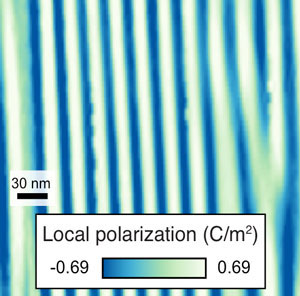| May 07, 2013 |
Imaging nanoscale polarization in ferroelectrics with coherent X-rays
|
|
(Nanowerk News) Seeing the fine-scale properties of materials relevant to nanotechnology is a prominent challenge that currently can be met only under ideal conditions. Coherent X-ray imaging promises to greatly expand the range of materials and environments in which these important properties can be observed.
|
|
Users from Argonne's Materials Science and Nanoscience & Technology divisions, in collaboration with the X-Ray Microscopy Group at the Center for Nanoscale Materials and researchers from the Advanced Photon Source, KAIST, Northern Illinois University, and the University of Melbourne, have reported ("Imaging Local Polarization in Ferroelectric Thin Films by Coherent X-Ray Bragg Projection Ptychography") the development of a new X-ray imaging technique, coherent X-ray Bragg projection ptychography, and its application to the study of nanoscale structures in ferroelectric thin films.
|
 |
| Stripe domain polarization map from X-ray Bragg projection ptychography phase reconstruction of a PbTiO3 thin film.
|
|
Under certain conditions, ferroelectric thin films (used, for example, in specialized computer memories) form networks of nanoscale domains with distinct local polarizations that are difficult to image because their properties are controlled by the film's surrounding environment. Noninvasive visualization of these polar domains under realistic boundary conditions is key to the continued development of ferroelectric devices.
|
|
The Bragg ptychography method employs a highly penetrating nanofocused X-ray beam to create spatially overlapping coherent diffraction images, which, in this study, were used to visualize nanoscale domain polarization in an epitaxially strained ferroelectric thin film of PbTiO3. With a demonstrated spatial resolution of less than six nanometers, this new quantitative imaging technique paves the way for the visualization of domain morphology and behavior inside ferroelectric heterostructures under relevant conditions.
|

